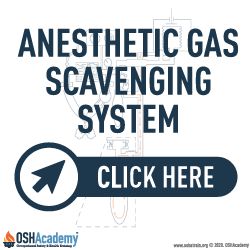Engineering and Administrative Controls
Engineering and administrative controls such as an appropriate anesthetic gas scavenging system are the first line of defense and the preferred method of control to protect employees from exposure to anesthetic gases.
A report from the Centers for Disease Control and Prevention found there is widespread use of these scavenging systems to control anesthetic gases during medical procedures. However, many other recommended controls are lacking in many facilities. Here are the results of the study:
- 3% did not always use anesthesia machines equipped with a waste gas scavenging system
- 35% started anesthetic gas flow before mask was applied to pediatric patient and 14% did the same for adult patients.
- 19% reported safe handling procedures were unavailable.
- 18% never received training on safe handling of anesthetic gases.
- 17% used a funnel-fill (open-air) system instead of a key-filler or other closed system to fill anesthesia vaporizers.
- 17% used high (fresh gas) flow anesthesia only for pediatric patients and 6% did the same for adult patients.
- 5% did not routinely check anesthesia equipment for leaks.
When precautionary practices are not followed, anesthesia care providers and bystanders are at risk of exposure. Ensuring proper precautionary measures are followed requires diligence on the part of both employers and healthcare workers.
Employers need to ensure the following:
- anesthesia care providers are initially and periodically trained
- safe-handling procedures reflecting recommended practices are in place
- anesthesia machines with scavenging systems are used (including regular inspection of anesthesia delivery equipment for leaks, periodic air and exposure monitoring prompt elimination of spills and leaks)
- medical surveillance, exposure monitoring, and other administrative controls are in place
Anesthesia care providers should seek out training, understand and follow facility procedures, ask questions, and report any safety concerns.
Knowledge Check Choose the best answer for the question.
1-4. What should employers do to protect care providers and bystanders from exposure to anesthesia?
You forgot to answer the question!

